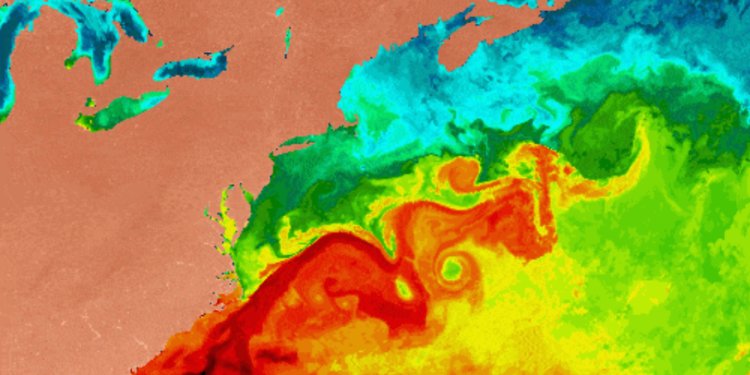Last year, Georgina Rannard of the BBC reported that “scientists say” a weakening Gulf Stream could collapse as early as this year, a dire process that would bring catastrophic changes in the weather in the northern hemisphere. Routine fear mongering, of course, from the Net Zero promoting BBC and this ‘tipping point’ scare is common among alarmists. After all, everyone knows about the 2004 dystopian Hollywood blockbuster The Day After Tomorrow. ‘Most of us are going to die’ is a great scoop, it is just a shame about the facts. Ground-breaking new work from scientists at the National Oceanic and Atmospheric Administration (NOAA) has discovered that the huge flow of tropical water through the Florida Straits has remained “remarkably stable” for over 40 years.
The Florida current is a key component of the Gulf Stream, which is an important part of the Atlantic Meridional Overturning Circulation (AMOC). This current flows north, raising temperatures in the higher latitudes by up to 10°C. Warm tropical water flows between the Florida Peninsula, Cuba and the Bahamas at speeds up to seven kilometres per hour and provides most of the heat taken north by the AMOC. The paper notes that several recent studies have used a possible flow decline to speculate about a collapse in the Gulf Stream and the AMOC. Thus, clickbait science papers using computer models have been picked up by mainstream media and politicians to provoke fear of a Gulf Stream catastrophe.
Using data derived from motion-induced change in submarine cable voltages, and adjusting for errors caused by past geomagnetic data processing, the NOAA scientists state that their new 40-year record “challenges” the previously made assertions on the statistically significant decline of the Florida current. The respected climate scientist Judith Curry has hailed the new paper from the U.S. weather service as “important” and notes that the AMOC is not weakening despite it being touted as a climate tipping point.
It is unlikely that mainstream media will touch this paper since it kicks much of their fear mongering on the Gulf Stream into touch. Last year’s excitement suggesting imminent collapse was caused by a paper written by Peter Ditlevsen from the University of Copenhagen, who told the constantly worried Guardian that “we should be very worried”. The alarmists’ alarmist Professor Stefan Rahmstorf of the Potsdam Institute for Climate Impact and Research said the Ditlevsen paper added to the “evidence” that the AMOC collapse “is much nearer than we thought”. We can’t rule out crossing the tipping point in the next decade or two, he added.
The NOAA scientists note that most climate models suggest a 34-45% decline in the present strength of the AMOC within less than 80 years. A number of ‘proxy’ records are said to indicate that the AMOC may already be slowing down on a centennial scale. There has been criticism of the Ditlevsen findings, with a subsequent paper observing that the uncertainties, mostly around sea surface temperature data, were too large to predict a tipping point for the AMOC. Such is the unreliability of climate computer models that the tipping point could occur anywhere between now and infinity. It all depends, it would seem, what is loaded into the model in the first place. But whatever is loaded, there appears to be a near guarantee that unquestioning activists in mainstream media will report any fear-packed message to a wider public.
Referring to the recent controversy, the NOAA scientists state that the ability of temperature based indices to represent the AMOC has been questioned. The recent reductions of sea surface temperatures in the subpolar North Atlantic is often assumed to be an indication of an AMOC slowdown. But the scientists suggest it could “largely be driven by the atmosphere alone without any changes in ocean circulation”. Further up the Gulf Stream, between New Jersey and Bermuda, the NOAAS authors go on to note that direct measurements from 1992 do not support suggestions that the AMOC has started to substantially slow down. Hydrographic data are said to be sparse, but “no significant weakening of the AMOC has been detected”.
The variations of the AMOC are being hotly disputed in scientific circles. Much of the research into this important ocean circulation is recent and a great deal needs to be learnt. The NOAA authors point out that investigating the variability of the Florida current “is of particular importance for detecting and better understanding changes in the Earth’s climate system, as well as for interpreting regional variations in weather, sea level and eco-systems”.
But all too often we see how ‘settled’ science – a harmful unwillingness to consider all climate variation other than those assumed to be caused by humans – debases much of the effort. ‘Blacklists’ of climate sceptics are compiled, academics lose their careers and fines and imprisonment are demanded for those who fail to toe the authorised line. Mainstream media only seem interested in silly sci-fi predictions of the imminent demise of the Gulf Stream. It grabs the headlines, is easy work if you can get it and plays out to an agreed political narrative. Like the multi-year record growth of coral at the Great Barrier Reef, the cyclical Arctic sea ice, the obvious corruptions in many temperature measurements and the astonishing CO2 ‘greening’ of the planet, the lies are all told by omitting obvious, easily obtainable and important facts.
Chris Morrison is the Daily Sceptic’s Environment Editor.












To join in with the discussion please make a donation to The Daily Sceptic.
Profanity and abuse will be removed and may lead to a permanent ban.